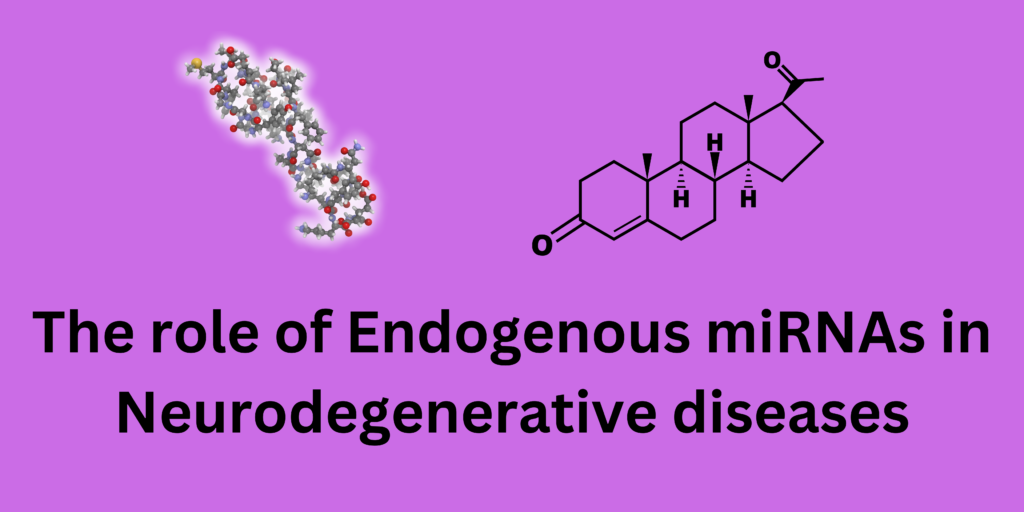Eight neurodegenerative disorders, containing AD, ALS, ataxia, dementia, HD, MS, PD, and prion conditions, have been considered in relation to endogenous miRNAs. The most of research has observed at AD in order to study the relationship between miRNAs and neurodegenerative disorders. The changes to separate miRNAs in animal models majority of neurodegenerative conditions and the related controlling mechanisms. mRNAs have two altered effects on the neurological system. Certain miRNAs offer defense, on the one hand. As an design, miR-15b, miR-107, miR-388-5p, miR-200a-3p, miR-31, and miR-29c can all directly affect BACE1 in AD, decreasing Aβ (Barros-Viegas et al. 2020; Jiao et al. 2016; Li and Wang 2018; Qian et al. 2019; Wang et al. 2019; Zong et al. 2011), decreasing the buildup of Aβ and acting as a cushion against AD. Furthermore, miR-15b has the capability to regulate the nuclear transcription factor-kβ signal (Dai et al. 2014). In the meantime, several ways and regulatory processes can be involved by miR-132, miR-212, miR-101a/b, miR-155a-5p, miR-142a-5p, miR-455a-5p, and miR-146a-5p to destroy tau protein phosphorylation (D. Liu et al. 2017a, b; Sierksma et al. 2018; Smith et al. 2015). Specially, miR-101a/b controls tau phosphorylation through two distinct routes, histone deacetylase 2 and mitogen-activated protein kinases (D. Liu et al. 2017a, b), although miR-132 and miR-212 can overwhelm tau phosphorylation by disturbing the stability of S-nitrosylation (Cha et al. 2019). By concentrating on glycogen synthase kinase-3β and the cyclin-dependent kinase 5 (CDK5)/PTEN/PPP2CA axis to stop tau protein from being phosphorylated, miR-155a-5p, miR-142a-5p, miR-455a-5p, and miR-146a-5p can regulator or openly act on tau protein (Sierksma et al. 2018). Though, some miRNAs can possibly be the source some degree of nervous system damage. As a design, a number of miRNAs are pro-inflammatory, boosting neuroinflammation and neuronal injury (Vezzani et al., 2011; Stephenson et al., 2018). The brain’s nuclear factor kappa B (NF-κβ) pathway permits the pro- and anti-inflammatory let-7 family (Roush and Slack 2008), the anti-inflammatory miR-21, miR-124, miR-146a, and miR-223 and the pro-inflammatory miR-155, miR-27b, and miR-326, (Gaudet et al. 2018).
The miR-29 family, the miR-34 family, miR-9, and miR-15 have conventional the maximum research consideration. For instance, miR-9 is the main miRNA used in regulating cell proliferation and differentiation, and the existence of neurodegenerative disorders is related to these processes (Khafaei et al. 2019). Apoptosis is a main factor in neurodegenerative disorders, and one of the important miRNAs controling apoptosis is the miR-34 family. The miR-34 family is regularly used in therapeutic situations to treat cancer (Hermeking 2010). However, the role of the miR-34 family in neurodegenerative diseases should not be ignored, as they are an important miRNA regulating programmed cell death (Bazrgar et al. 2021). There is no negating the importance of pro-inflammatory, immune-mediated processes in the etiology and growth of neurodegenerative diseases. In addition, miR-15 control cellular immunity and plays a role in the development and course of neurodegenerative diseases (Hutter et al. 2021). In the intervening time, it has an extensive contribution in many dissimilar processes and is also concerned in apoptosis, cell differentiation, and proliferation. Furthermore, the miR-29 family controls the immune reaction, cell division, apoptosis, and multiplication (Alizadeh et al. 2019; Sharma et al. 2021). It also shows a part in the controling of many brain channels (Swahari et al. 2021).



